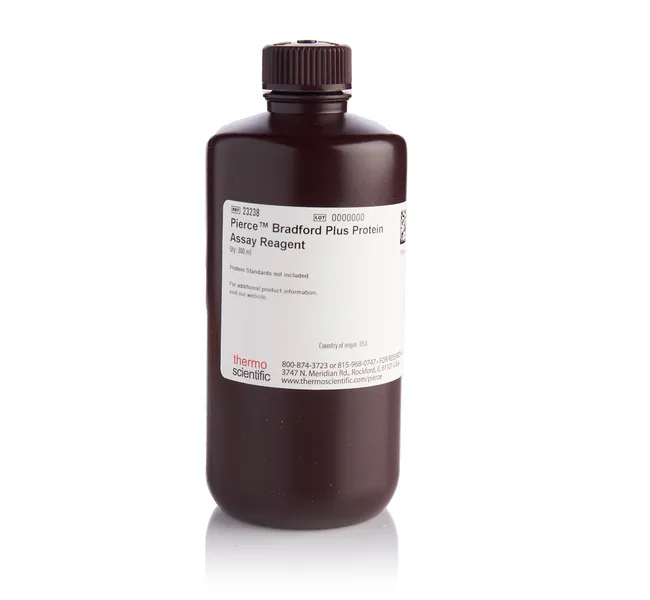
The Pierce Bradford Plus Protein Assay is a ready-to-use, reducing agent-compatible, improved Bradford assay reagent to quickly measure total protein concentration compared to a protein standard. The Pierce Bradford Plus Assay Reagent provides increased linearity and half the protein-to-protein variability of other commercial Bradford assay formulations.
Compare all available Bradford assays ›
Features of the Bradford Plus Protein Assay include:
• Colorimetric—measure with a standard spectrophotometer or plate reader at 595 nm
• Easy to use—single reagent; no working reagent preparation required
• Fast—almost immediate color development; add, mix, and read results
• Assay range—detects protein concentration in the range 1 to 1500 μg/mL
• Better—improved linearity and response uniformity compared to traditional Bradford formulations
• Flexible—microplate and cuvette protocols provided and adaptable to several target working ranges
The Pierce Bradford Plus Assay Reagent is a single, ready-to-use solution for measuring protein concentration. Simply add the reagent to equal volumes of samples and standards, mix, and then measure the absorbance at 595 nm. The assay can be performed in either test tube or microplate format. The protein assay is compatible with most salts, solvents, buffers, thiols, reducing substances, and metal chelating agents encountered in protein samples.
How the Bradford Plus Assay detects protein
Use of Coomassie G-250 dye in a colorimetric reagent for the detection and quantitation of total protein was first described by Dr. Marion Bradford in 1976. In the acidic environment of the reagent, protein binds to the Coomassie dye. This results in a spectral shift from the reddish/brown form of the dye (absorbance maximum at 465 nm) to the blue form of the dye (absorbance maximum at 610 nm). The difference between the two forms of the dye is greatest at 595 nm, so that is the optimal wavelength to measure the blue color from the Coomassie dye-protein complex. If desired, the blue color can be measured at any wavelength between 575 nm and 615 nm. At the two extremes (575 nm and 615 nm) there is a loss of about 10% in the measured amount of color (absorbance) compared to that obtained at 595 nm.
Development of color in Coomassie dye-based (Bradford) protein assays has been associated with the presence of certain basic amino acids (primarily arginine, lysine, and histidine) in the protein. Van der Waals forces and hydrophobic interactions also participate in the binding of the dye by protein. The number of Coomassie dye ligands bound to each protein molecule is approximately proportional to the number of positive charges found on the protein. Free amino acids, peptides, and low molecular weight proteins do not produce color with Coomassie dye reagents. In general, the mass of a peptide or protein must be at least 3,000 daltons to be assayed with this reagent.
Related products
Pierce Bradford Plus Assay Kit
Pierce Detergent Compatible Bradford Assay Kit
Pierce Dilution-Free BSA Protein Standards, Multichannel Pipette Compatible, 0.125–2 mg/mL
| Code | Description |
|---|---|
| 23238 | Catalog Number: 23238 |

